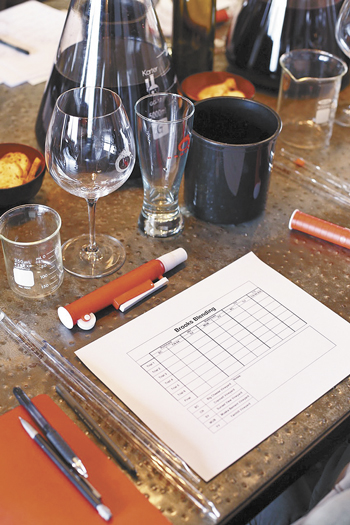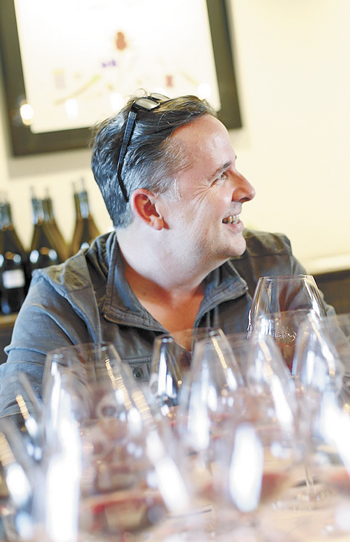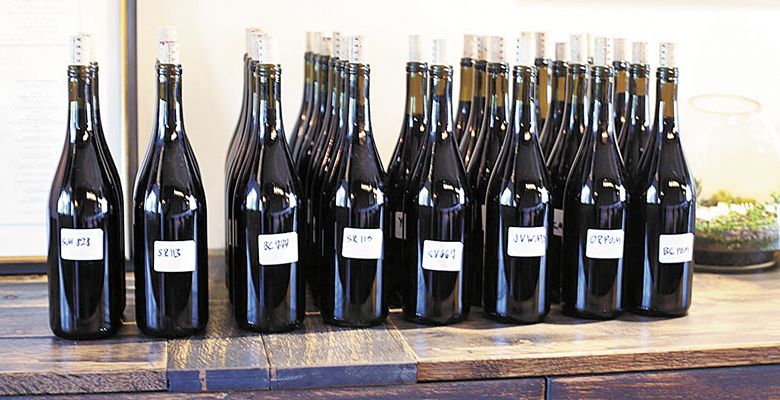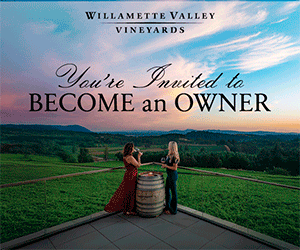That’s Somm Blend
Brooks hosts educational winemaking experience
In early May, five top sommeliers from around the country gathered at Brooks Winery to create a personalized Pinot Noir blend for each of their respective restaurant programs. In order to create a successful wine, they first had to understand what goes into a blend, and at Brooks, that means getting to know upwards of 50 individual lots.

“It was at a stoplight,” says winery director Janie Brooks Heuck, when she first considered the idea of a sommelier blending experience. It was also bottling time, and watching winemaker Chris Williams inspired her.
“When you watch Chris bottle, you really learn to appreciate the art and mastery of blending,” Brooks Heuck said. “We don’t use large tanks for anything, and buy from close to 20 different vineyards and have about 10 different clones. With such variation in each lot, I thought, what an awesome experience it would be for others to get to taste and learn.”
The sommeliers included: Ryan Arnold of Lettuce Entertain You Enterprises in Chicago; Steve Morgan, formerly of Formento’s, also in Chicago; Brooke Sabel from Natirar in Peapack, New Jersey; Jennifer Knowles of The Jefferson Hotel in Washington, D.C.; and Lucas Henning from Graft in Madison, Wisconsin. Master Sommelier Chris Blanchard was also on hand as an instructor.
As an additional participant in this extraordinary experience, I discovered how creating a custom wine is not an easy task.
On the first of this two-day event, we were asked to taste 32 Pinot Noir barrel samples broken down by clone and site. The lots represented nine clones from 15 vineyard sites planted between 1974 and 2009 located in five Willamette Valley AVAs. We studied the distinctions of each with the help of Blanchard’s analogy of building a house.
“Some wines are the foundation, while others are the bells and whistles and little details,” he explained.
 Each person was given tools to aid in and better understand the art of blending. ##Photo by Mary Cressler
Each person was given tools to aid in and better understand the art of blending. ##Photo by Mary CresslerSimplifying a complex topic, he described the numbered Dijon clones — 777, 115, 667… — as Vegas clones. “They’re showy and big, like granite kitchen countertops.” Pommard, on the other hand, “is more of a backbone clone, giving structure and power; it’s a good base or foundation.” Meanwhile, Wädenswil can provide high-toned fruit aromatics and elegance to a blend, much like the finishing touches to a house, like adding upscale appliances, silk curtains and decorations.
The clones will, of course, express themselves differently based on where they are planted, but this was a good starting point to understand how they might work together, like the combined elements of a finished home.
We also learned how vineyard sites contribute to the flavors of the wines as well. Of the 20 from which Brooks sources, we tasted 15, including the winery’s estate vineyard located in the Eola-Amity Hills. Within this site alone, individual lots were pulled from blocks planted between 1974 and 2001 containing a mix of Nekia and Jory clay loam soils.
Others, like Yamhill Vineyard, in the Yamhill-Carlton AVA, contain a mix of Dupee silt loam and Willakenzie and Panther silty clay loam. Some sites are additionally known for their location, like Temperance Hill Vineyard, which benefits from the windy Van Duzer Corridor.
The combination of each factor matters when it comes to successful blends; this complexity is what Brooks Heuck is excited to share with others.
“We have such a great opportunity to show people the difference in clones, vine age, site, because we [produce wine] in such small lots,” she offered. “I imagine there aren’t too many wineries of our size, 25,000 cases, [using only] 2.5-ton fermenters. I see this as a testament of Chris’ hard work and approach to the way we make our wines.”
When it was time to create our blends, Blanchard shifted his analogy to cooking, using a favorite lamb recipe as an example. He explained how he adds several anchovies into his lamb roast. “Everybody hates anchovies,” he pointed out, “but without the anchovies, the dish wouldn’t be nearly as good.” He warned that though there may be an individual lot you might not love alone, when blended with something else, it can shine.
Throughout the next day, in a room more reminiscent of a science lab than a romantic barrel room — full of oversized flasks, measuring devices and nearly a dozen wines from which to choose — each somm went to work blending.
Henning says he began with the goal of “making a wine that had a high level of aromatics, and a rich silky texture. One drinkable with or without food.” The wine he created for his restaurant, Graft, ended up being equal parts Dijon 667, 777 and 115.
“I took the clone that I thought had the best aromatics, then added the one I thought had the best front and mid-palate density, and the final piece was the clone with the best back palate.”
Balancing earth, acid and tannins, Knowles sought to create a wine with a “classic” Pinot Noir profile: medium-bodied with red fruit flavors and hints of both fresh and dried florals. Willamette Valley Pinot Noir is the highest selling red wine by the glass in every aspect of her program, including restaurant, lounge and room service. “So my goal was to create a blend that held true to what my guests tell me they enjoy.”
Her finished wine was a complex mix of four sites and four clones — the primary being Wädenswil followed closely by Dijon 667, with Pommard and 777 making up the remaining. One wine she loved on its own, and contemplated a single vineyard bottling. But she decided against that, explaining “A single vineyard can be so beautiful and pure, but sometimes the myriad of voices in a choir can be even more amazing when they come together to form a perfect blend of highs and lows.”
“Having the chance to make a custom blend for our property was such an extraordinary opportunity,” Knowles expressed, “and the fact that it happens to be for the red wine we sell the most by the glass was amazing.”
Her enthusiasm was unanimously reflected by the group. It was an experience that opened eyes, challenged assumptions, focused palates and resulted in some fantastic Pinot Noir blends to be released to each sommelier’s respective restaurant this September.
Mary Cressler is a wine, food, and travel writer, and author of the award-winning blog Vindulge. She is also a wine educator and lives in Portland.











